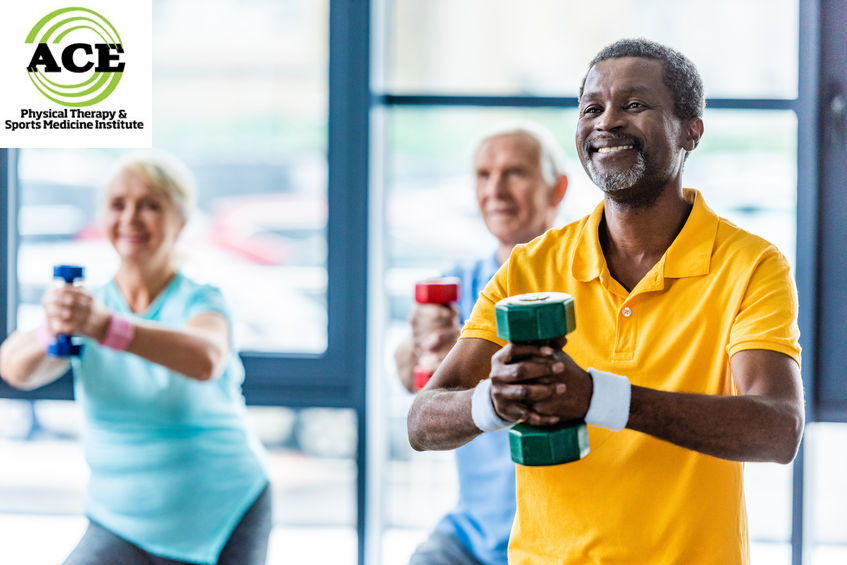PROTECTING BONE DENSITY WITH RESISTANCE EXERCISE

Tid Bits of Info
- Osteoporosis means porous bones.
- More than 3 million cases of osteoporosis are diagnosed yearly.
- More than 60% of all osteoporotic fractures occur in women over the age of 60.
- Fractures of the hips, spine and distal wrist are the most common sites for osteoporotic fractures.
- Seek the advice and treatment of a Physical Therapist to develop an exercise routine designed to stimulate bone cell production.
Bones are alive. These rigid, living tissues not only provide support for the body and protect the internal organs. They also produce red and white blood cells, store proteins and minerals, and can even repair themselves. Bone density or bone mineral density (BMD) levels should be high and when they are not maintained at a high level it could be a precursor for poor bone health later on in life. Resistance exercises can play a key role in maintaining proper bone density levels.
As we age, it is vital to maintain exercise routines that promote bone density and avoid joint damage. Low levels of BMD have been linked to the onset of osteopenia and osteoporosis.
Osteopenia is a “thinning or weakening” of the bone. It is not as advanced as osteoporosis and the bone is not as weak as a bone that has osteoporosis, but it should be a warning sign of possible changes that might take place in the future. The person who suffers from osteopenia, which is diagnosed with a bone density test, are more susceptible to bone fractures than a person who has normal bone density, but not nearly as likely to suffer the fracture compared to a person suffering from osteoporosis.
Osteoporosis literally means “porous bones.” Bones are living material and they constantly “break down” and are replaced with new bone cells. In youth, the process occurs that favors the production of new bone usually reaching the maximum bone density in the thirties. As someone ages and nears the end of the 3rd decade, the production of new bone cells is usually slowing down and might not keep pace with the “breakdown.” When this occurs there are seldom any symptoms that would enable that person to know that it is happening until it is too late. When the “breakdown” exceeds the production the bones become weaker and more susceptible to fractures.
The most common sites of fractures for a person suffering from osteoporosis are the spine, hips and wrists. Many times a fall or simply a forceful cough can lead to a fracture site. The person will often times go to the emergency room or their doctor due to pain in a body part and discover that they have a fracture in one of the bones. X-rays can reveal some of the quality of the involved bone, but a bone density test is needed to fully diagnose BMD.
As the population ages, many healthcare professionals promote low impact or no impact exercise routines to avoid joint damage. The belief that high impact forces can lead to joint cartilage damage and eventually osteoarthritis has lead them to promote routines like cycling and swimming. These are great exercise routines to maintain cardiovascular fitness, but they don’t have much effect on the quality of the bones. If fact, most studies that are reported on cyclists or swimmers who do not participate in any other form of exercise, have a lower BMD compared to sedentary people their own age. These studies show the importance of adding resistive, weight-bearing exercises to these routines to help maintain a proper BMD.
Resistance exercises can be performed in conjunction with a low impact routine and not cause joint damage. There are some studies that support the use of full body vibration to place a “load” on the bones. The use of a vibrating platform is most popular for individuals who cannot perform weight-bearing resisted exercises. The effectiveness of a vibrating platform is still unknown but appears to be most effective on post-menopausal women. The need to put a force across the bones to enhance new cell growth has been documented and supported in numerous studies. Implementing any weight bearing / resisted exercise routine that does not cause further joint damage is one of the keys to maintaining healthy bones.
Seeking the advice of a Physical Therapist to help you develop a solid exercise routine that will be safe for your current condition is a really good place to begin the process of building healthy bones. These healthcare professionals can be visited without a doctor’s prescription but your insurance policy might require a referral from your PCP.
Maintaining proper BMD is important for all ages because the amount of bone density developed during the early stages of life can determine how well BMD is maintained as someone ages. Low BMD can lead to osteopenia or osteoporosis and cause a host of health problems. Performing resistance exercises is the best way to maintain healthy bones throughout one’s lifetime.
